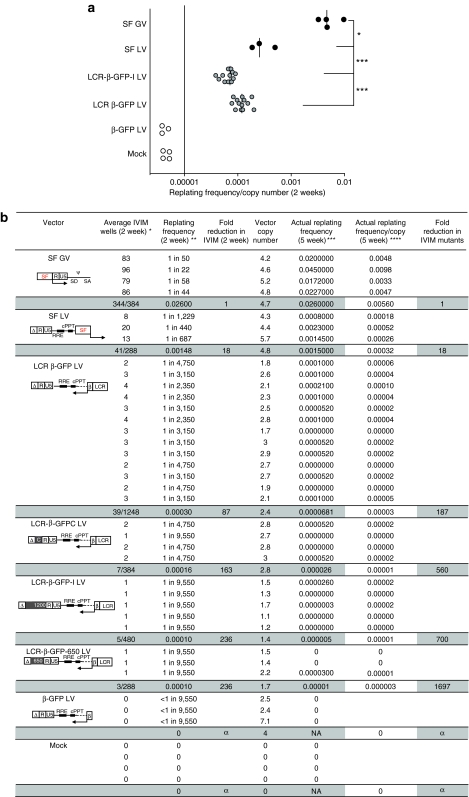Figure 1.
Frequency of generation of IVIM clones from lineage-negative primary hematopoietic cells scored at 2 weeks and at 5 weeks (actual replating frequency). (a) Two-week replating frequency (x axis) per vector copy. The y axis shows a schematic representation of the vectors. The regions of the 5′LTR are represented as U3, R, and U5. δ represents self-inactivating long terminal repeat (LTR) U3 enhancer deletion. The detailed vector maps are shown in Supplementary Figure 1. The in vitro immortalization (IVIM) clonal frequency of SF GV, a vector driven by the spleen focus forming virus (SFFV) LTR, and SF LV, carrying an internal SFFV promoter/enhancer was compared to LV carrying the lineage specific β-globin promoter and LCR enhancer (LCR-β-GFP). The replating frequency of three LCR-β-GFP insulated LV carrying different cHS4 insulator fragments in the U3 deletion (shown as a filled box) are combined and plotted. Rev-response element and central polypurine tract are indicated. Arrows indicate the orientation of gene transcription from the provirus. An enhancer-less vector, carrying only the β-promoter and mock transductions were negative controls. All vectors were compared with the SF GV (SF91.eGFP.pre) for their genotoxic potential using Student's “t”-test (unpaired and two tailed). Open circles represent the replating frequency/copy number from independent transductions. Open circles below the horizontal line indicate independent transductions, which did not give rise to any replating clones. Replating frequency was normalized for the mean copy number in the pooled cell population prior to replating. Median is indicated by the black line. P-values are *P < 0.05, ***P < 0.001 indicated in the graph. (b) Frequency of IVIM assay mutants following replating at 2 weeks and 5 weeks. Vector diagrams are as in a. Each row represents an individual experiment. Gray bars summarize results of a vector type, providing the number of wells with IVIM clones versus the total wells plated. Replating frequency was assessed at 2 weeks, as per the standard IVIM assay,5 and cells in each positive well expanded for 3 weeks for analysis. Only 12/36, 2/7, 2/5, and 1/3 clones identified at 2 weeks with the LCR-β-GFP, LCR-β-GFPC, LCR-β-GFP-I, and LCR-β-GFP650, respectively, expanded further and sufficient cells were available for analysis. The actual replating frequency was therefore calculated at 5 weeks. Only select clones from SF GV or SF LVs were chosen for expansion and all expanded robustly. *Number of wells showing clonal growth when 100,000 Lin− cells, transduced, expanded, and replated as 100 cells/well in 96-well plates. **L-Calc Software was used to calculate the replating frequency using # wells showing IVIM mutants, total number of wells plated. ***Assuming a direct correlation between in vitro immortalization potential and copy number. ****With LCR-containing vectors, only one third of the wells that showed expansion at 2 weeks could be expanded at 5 weeks to get sufficient cells for RNA, FACS, and DNA analysis. All wells picked for expansion with the SFFV driven GV or LV vectors were expanded robustly at 5 weeks, and expansion of SF driven vectors was 4.5 ± 1.2 higher. Note: Only select clones were expanded with the SF GV or LV vectors. NA, not applicable; RRE, Rev-response element; cPPT, central polypurine tract; α, infinity.

